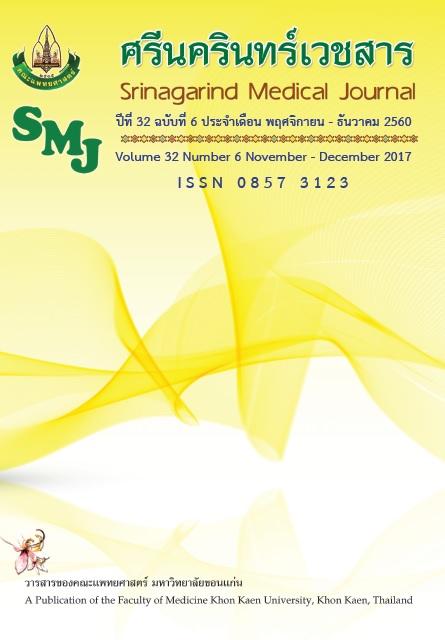Maternal-Fetal and Neonatal Clinical Characteristics of Down Syndrome at Srinagarind Hospital
Keywords:
Down syndrome; Characteristic; Maternal; Fetal; Neonatal; กลุ่มอาการดาวน์ ลักษณะทางคลินิก; มารดา; ทารกในครรภ์; ทารกแรกเกิดAbstract
Objective: To describe maternal-fetal and neonatal clinical characteristics of Down
Syndrome (DS) at Srinagarind Hospital.
Materials and Methods: The present study was a retrospective descriptive study. The
authors recruited all pregnant women who delivered babies with DS at Srinagarind hospital
between January 1, 1993 and December 31, 2012. Histories of all participants were obtained from medical records. Clinical characteristics of them were recorded in case record form (CRF). The statistics used to describe the clinical characteristics were percentage.
Results: The incidence of DS at Srinagarind hospital was 0.61 in 1,000 of total births. 57% of pregnant women who delivered babies with DS are 35 years or older. 52% delivered before term gestation and had no abnormal obstetric history in previous pregnancies. Only 18% had definite prenatal diagnosis. DS babies occur more frequently in infants of diabetic mothers. The most common ultrasonographic finding of the fetuses with DS in our study was asymmetrical intrauterine growth restriction. For full term neonates with DS, the average value of head circumference was slightly smaller than normal.
Conclusion: Incidence of DS at Srinagarind Hospital was 0.61 in 1000 of total births.
In this study, advanced maternal age and maternal gestational DM, probably, may be the important risk factors of having a child with DS. Definite prenatal diagnosis was still
lower rate. For neonatal clinical characteristics, head circumferences were smaller in DS
babies.
References
Gynecol 1981; 58: 282–5.
2. Kuller JA, Laifer SA. Contemporary approaches to prenatal diagnosis. Am Fam
Physician 1995; 52: 2277–83.
3. Merkatz IR, Nitowsky HM, Macri JN, Johnson WE. An association between low
maternal serum alpha-fetoprotein and fetal chromosome abnormalities. Am J Obstet
Gynecol 1984; 148: 886–94.
4. Hassib N, Naji K. High incidence of Down’s syndrome in infants of diabetic mothers.
Arch Dis Child 1997; 77: 242-4.
5. Mandal A. Down syndrome symptoms. News-Medical. January 26, 2015.
6. Benacerraf BR. Ultrasound of fetal syndromes. New York: Churchill Livingstone,
1998: 328–38.
7. Vintzileos AM, Campbell WA, Rodis JF, Guzman ER, Smulian JC. The use of
second-trimester genetic sonogram in guiding clinical management of patients at
increased risk for fetal trisomy 21. Obstet Gynecol 1996; 87: 948–52.
8. Chitty, Lyn S. Antenatal screening for aneuploidy. Curr Opin Obstet Gynecol 1998
Apr;10(2): 91-96.
9. Gross SJ, Bombard AT. Screening for the aneuploid fetus. Obstet Gynecol Clin North
Am 1998; 25: 573–95.
10. Physical growth in newborns. E-medicine-health. January, 2015: 1-2.
11. Smith DW, Jones KL. Smith's recognizable patterns of human malformation. 4th ed.
Philadelphia: Saunders, 1988: 10–5.
12. Tolmie JL. Down syndrome and other autosomal trisomies. In: Rimoin DL, Connor
JM, Pyeritz RE, eds. Emery and Rimoin's principles and practice of medical genetics.
3rd ed. New York: Churchill Livingstone, 1996: 925–71.




